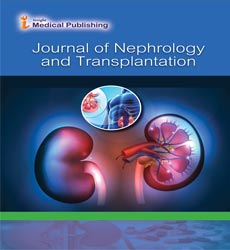Influence of the Dialyzer Design on the RRT
Thomas Ryzlewicz*
Dialysis Centre, ViaMedis Riesa, Germany
- *Corresponding Author:
- Thomas Ryzlewicz
Senior Consultant Nephrologist, Dialysis Center
ViaMedis Riesa, Robert-Koch-Strasse 30
D-01589, Riesa, Germany
Tel: +49 172 836 66 25
E-mail: thomas.ryzlewicz@web.de
Received Date: October 23, 2017 Accepted Date: October 24, 2017 Published Date: October 26, 2017
Citation: Ryzlewicz T (2017) Influence of the Dialyzer Design on the RRT. J Nephrol Transplant Vol.1: No.1: e001.
Editorial
Physical Chemistry had used dialysis along a semipermeable membrane as a way of separation–for small molecules. Kolff and Alwall had introduced this way of separation to start renal replacement therapy, extended as fascillated diffusion by the blood flow. They both had used the excellent diffusive facilities of regenerated cellulose. In 1960, the clinical therapy of CKD 5 patients had started with this membrane. In 1978, hemofiltration started with patient’s treatment, using synthetic high-flux membranes. These high-flux membranes had bigger pores and a much higher KUF, due to the different way of treatment (convection resp. solvent drag). The synthetic membranes are much more biocompatible than the membranes of regenerated cellulose. Whenever there was also a product line of synthetic low-flux dialyzers, the majority of treatments does use high-flux dialyzers up today. Two wellknown big studies (HEMO and MPO, each of them 5000 patients, prospective randomized) resulted in no better survival for the high-flux dialyzer, but this had not changed in the spreading of it. This behavior was a hygienic risk, due to the internal filtration of unsterile dialysis fluid. Only in 2009, the ISO norm 11663 appeared to require one-step dialysisfluid ultrafiltration for high-flux dialysis.
A high-flux membrane used in the right way, this only has fulfilled in the convective therapy, as the bigger molecules only will leave the fluid compartment of the patient by filtration. The amount of internal filtration (high-flux-HD) is by far too small. A sufficient clearance of bigger molecules according to the sieving coefficient (QS) will only reached with high volumes of the solvent drag. Best option since 27 years is the combination of diffusive and convective facilities in the online- HDF. Canaud had concluded referring to own retrospective results in 2004, that there will be a better survival for the online-HDF in comparison to the standard dialysis. In 2013, three studies had published (ESHOL, CONTRAST and the Turkish online-HDF study, all prospective randomized multicentres studies). Only in the CONTRAST study, there was a proven better survival for the treated patients. The details? Treatment time was too short in all three studies. All of them had used the post-dilution admission of the infusate (the assessment of the cons of the post-dilution had not seen, big secondary protein membrane and the longer way of diffusion in the packed cell volume by the high TMP). The Turkish study failed in extent of the exchanged volume, due to the postdilution driven in the volume mode. This result was only a little better than the internal filtration of a high-flux HD. ESHOL and CONTRAST had used (pressure driven) auto-processing (instead of the volume mode in the Turkish study). Why they both had reached only smaller exchange volumes with autoprocessing? It is the continuously elevated KUF in the design of high-flux dialyzers. There will be a raised internal filtration in the high-flux HD, payed a high price for the elevation of the systemic pressure (blood pressure entry, BPE) up to one entire mechanical atmosphere (>700 mm Hg) in the post-dilution online-HDF. These high pressures do not belong in a biological system! Because of this, there is a down-regulation of the TMP by the auto-processing. With other words: With former 2.0 m² high-fluxes, a convective exchange a 6.0 litres per hour was available. With the high-flux dialyzers of today (2.0 m² surface), there remain only 5.0 litres per hour. CONTRAST had reached this even.
A better survival of CKD-5 patients in the comparison with the standard therapy you only will reach with a bigger treatment time together with a big convective exchange volume. The mode of pre-dilution (online-HDF in volume mode) does avoid the very high systemic pressures with the high-flux dialyzers of today. Moreover, the convective exchange can be elevated in pre-dilution to 7.5 or 9.0 litres per hour with low TMP. The actual design of the high-flux dialyzers is detrimental for the real therapeutic target, the convective therapy.
Open Access Journals
- Aquaculture & Veterinary Science
- Chemistry & Chemical Sciences
- Clinical Sciences
- Engineering
- General Science
- Genetics & Molecular Biology
- Health Care & Nursing
- Immunology & Microbiology
- Materials Science
- Mathematics & Physics
- Medical Sciences
- Neurology & Psychiatry
- Oncology & Cancer Science
- Pharmaceutical Sciences
